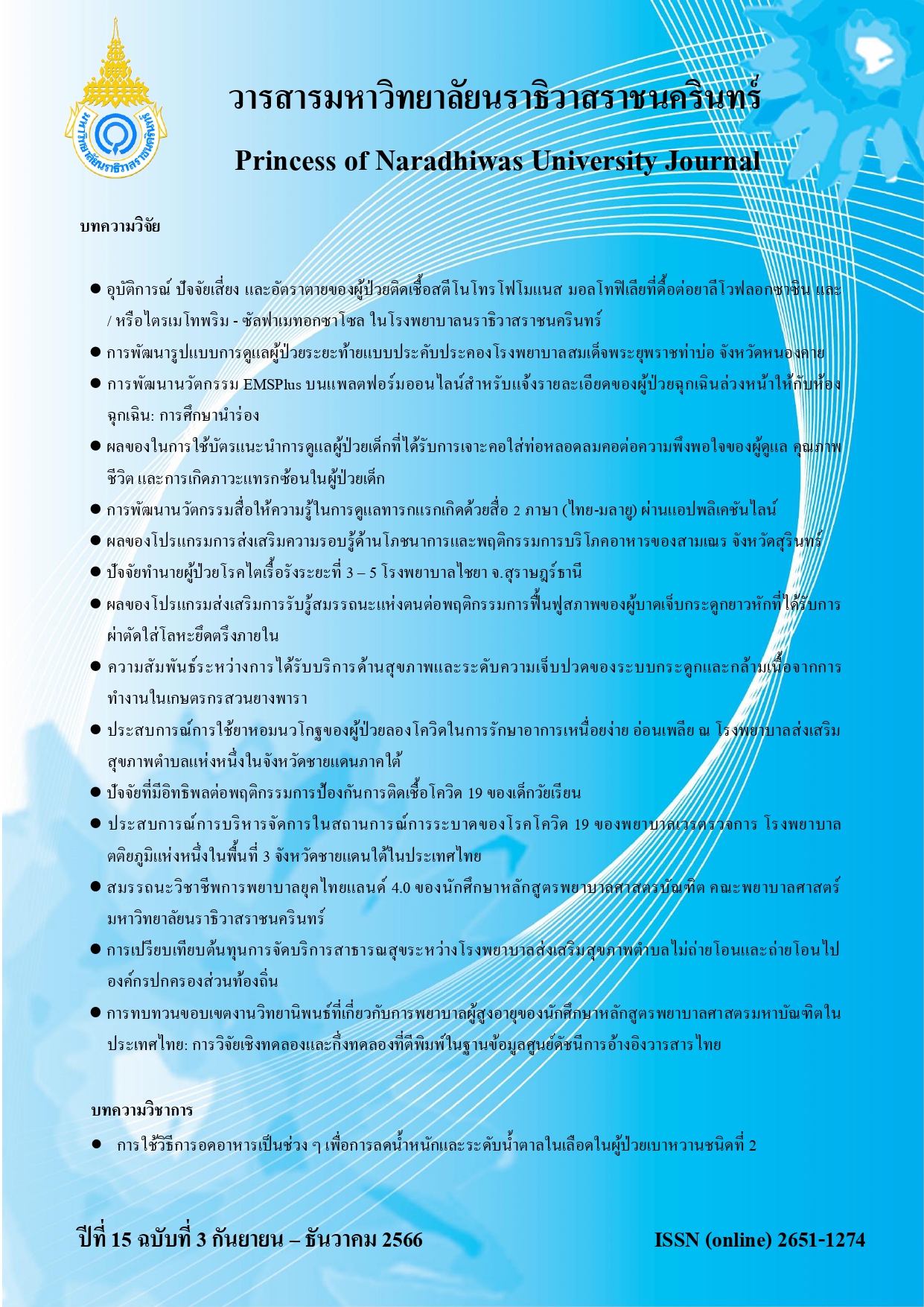Development of Innovative EMS Plus Online Platform for Informing Emergency Patients with Information Before Arriving at the Emergency Department: A Pilot Study
Keywords:
Innovative Emergency Medical Service Plus, Online platform, Emergency callAbstract
The research and development aimed to enhance a special channel for informing emergency patients about their medical emergencies (Innovative EMS Plus) and to determine the feasibility and satisfaction of utilizing the Innovative EMS Plus for informing emergency patients that needed emergency care. There were three processes of conducting the study included: (1) situational and need analysis for developing the Innovative EMS Plus with 29 emergency patients and Pattani hospital utilizer, and 10 officers who provide emergency medical services, including physicians, nurses, and supporting units; (2) Trial the Innovative EMS Plus by testing feasibility with 33 officers who provide emergency medical services that have some networking in three southern border provinces by dividing for testing feasibility of program with 23 persons, and testing the efficacy of the program with 10 persons; and (3) Evaluate the satisfaction of utilizing the program with 23 emergency medical personnels who have some networking in three southern border provinces and 103 health community volunteers who have network with the hospital totaling 126 persons. The instruments used in this study included measurement of perspective and the need for emergency medical care, and the feasibility and satisfaction of utilizing the program instrument. Data were analyzed by using descriptive statistics.
The results found that the Innovative EMS Plus, which was created on an online platform, consisted of the following three primary parts: (1) A person who reported an emergency issue; (2) information about reporting to the emergency department; and (3) knowledge package of emergency management for population. The overall and item scores for the feasibility of utilizing the program were in the medium range (M=3.25, S.D. = 0.75). The highest score was the use of knowledge from the system's knowledge package for recommending basic emergency medical care. The overall and item-by-item satisfaction scores after utilizing the program were quite high. This newly created innovation provides a channel for emergency patients who need travel independently to the hospital to seek emergency medical treatment. However, further research should be carried out to assess the efficacy and outcomes of patients after utilizing the innovation.
References
Chamnongprasartporn, W., Chanthong, S., Thammato, N., & Tasupha, Y. (2021). Development of a system linking programs related to medical and public health emergency care services. Chiang Mai: Siam Pim Nana. (in Thai)
Chomphet, P., Klangka, P., Nomkusol, J., Kamou, S., Kanchanasathien, R., Thongcham, R., Srisathaporn, U., & Srisathaporn, P. (2022). Development of “Smart Heart Care Application” in caring for patients with cardiovascular disease. Chiang Mai: Siam Pim Nana. (in Thai)
Jaffe, T.A., Hayden, E., Uscher-Pines, L., Sousa, J., Schwamm, LH., Mehrotra, A., & Zachrison, K.S. (2021). Telehealth use in emergency care during coronavirus disease 2019: a systematic review. Journal of the American College of Emergency Physicians Open 2(3), e12443.
Intawong, K., Vijitraphan, T., & Trisattayakul, P. (2022). Development of a seamless intelligent patient screening system SPEEDY ER PLUS. Chiang Mai: Siam Pim nana. (in Thai)
Khansakorn, N., Silawan, T., Rawiwaraku, T., Kittipichai, W., & Laothong, U. (2016). The Study on Emergency Medical Service for The Elderly. Nonthaburi: National Institute for Emergency Medicine. Retrieved January 6, 2023 from https://www.niems.go.th/1/upload/migrate/file/255911291527463047 _276dqvbz2kfisI9b.pdf.
Kitrungrote, L., KuptKanchanakul, W., Saexia, W., Phromnoi, C., Sangchan., H., Jitsuwan, N., … Chomthong, A. (2022). Model Development for Access to Emergency Medical Services for Elderly Patients with Stroke. Chiang Mai: Siam Pim Nana. (in Thai)
Klasuban, C. (2018). Guideline for ER service delivery. (2nd ed.). Retrieved January 6, 2023 from https://www.dms.go.th/backend//Content/Content_File/Population_Health/Attach/25621021104538AM_55.pdf?contentId=18327.
Lawang, W., Suksawatchon, U., Suksawatchon, C., & Tasanathanachai, A. (2019). Developing ‘Smart Caregiving’ Application to Support Caregivers of Persons with Mobility Disability. Chonburi: Burapha University. (in Thai).
McHugh., C., Krinsky., R & Sharma., R. (2018). Innovations in Emergency Nursing: Transforming Emergency Care Through a Novel Nurse-Driven ED Telehealth Express Care Service. Journal of Emergency Nursing, 44(5), 472-477.
National Institute for Emergency Medicine. (2021). Application EMS 1669. Retrieved December 13, 2022 from https://www.niems.go.th/1/SubWebsite/?id=1055.
Paralee, P., & Pearkao, C. (2019). Factors Predicting Overcrowding in Emergency Room of a University Hospital. Songklanagarind Journal of Nursing, 40(2), 52-65.
Planning and Strategy and Information Strategy and Information Group. (2021). Strategic Plan Development of Health Zone 12, 3-year period, 2021-2023. Retrieved May 30, 2023 from http://www.rh12.moph.go.th/news/2022-02-25_annual_report_2565.
Wongrattana, C. (2007). Techniques for using statistics for research. Nonthaburi: Thai Neramitkit Inter Progressive. (in Thai).
Published
How to Cite
Issue
Section
License
Copyright (c) 2023 Princess of Naradhiwas University Journal

This work is licensed under a Creative Commons Attribution-NonCommercial-NoDerivatives 4.0 International License.




